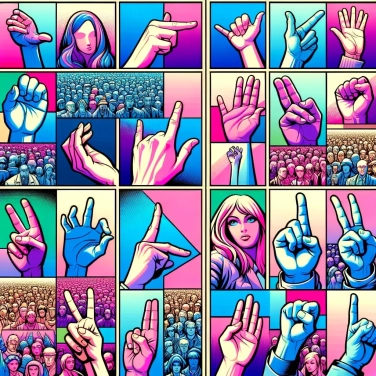Hand gestures have different meanings across cultures due to the influence of traditions, values, social norms, and beliefs specific to each society. These cultural differences shape the way gestures are interpreted and used in nonverbal communication.

Some hand gestures derive their meaning directly from religious or historical rites. For example, the gesture of the raised hand, palm open, was an ancient sign of peace to show that one was not carrying a concealed weapon. The "thumbs up" sign that we all know dates back to the time of Roman gladiators, but contrary to what one might think, it actually signified death rather than the joyful victory it represents today. Similarly, gestures associated with the right or left hand are sometimes linked to religious or symbolic concepts of purity and impurity found in several ancient cultures. In other words, if our gestures have such varied meanings today, it is often because they refer, without us even realizing it, to specific historical or religious legacies.
Hand gestures can quickly change meaning depending on the social and relational context in which they are used. The same gesture can express friendship, respect, or quite the opposite depending on the relationship between the people involved (close friends, colleagues, strangers). For example, giving a thumbs up can be positive and friendly among friends, but considered disrespectful in certain more formal situations or countries. Another telling example: pointing at someone may seem trivial in a friendly context in France, but is perceived as a sign of rudeness elsewhere. The precise meaning of a gesture often also depends on the tone, overall body language, and facial expression that accompany it.
Each culture has its own limits on what is considered well-mannered or, conversely, rude. For example, giving a thumbs-up gesture commonly means OK or approval in the West, whereas in the Middle East, it can be compared to showing the middle finger. Similarly, pointing at someone may seem harmless to some, but in several Asian or African cultures, it is viewed very negatively, as it is seen as aggressive or disrespectful. What is completely normal or even positive for one group can quickly become awkward or shocking elsewhere. Therefore, understanding these differences helps avoid awkward or even offensive misunderstandings.
With globalization and cultural mixing, hand gestures travel from one country to another, sometimes losing their original meaning. A gesture that is commonplace for us can become extremely popular elsewhere thanks to films or social media. Take the famous thumbs-up: after seeing it repeatedly in Hollywood cinema or on Instagram, many cultures that didn’t use it before have adopted it. But be careful, these borrowings are not always well mastered or fully understood. As a result, some adopted gestures lose their initial meaning or gain new ones, sometimes funny or unexpected. These are nice misunderstandings when traveling, but potentially embarrassing as well! Cinema, the internet, and TV series greatly influence gestural behaviors, creating sorts of "universal habits" that sometimes disrupt local traditions.
The thumbs-up sign, commonly used in the West to mean 'OK' or 'well done', can be interpreted as insulting in some Middle Eastern countries, particularly in Iran or Iraq.
In Japan, pointing at a person or an object is often seen as impolite. It is preferable to discreetly indicate the entire direction with an open palm.
The gesture of joining the thumb and index finger to form a circle, generally recognized as 'OK' in many Western cultures, can be considered extremely offensive in Brazil.
In India and Sri Lanka, gently shaking the head from side to side does not necessarily mean 'no' but is rather used to express agreement, approval, or simply to signal attentive listening.
In case of a misunderstanding related to a misinterpreted gesture, it is essential to quickly offer your apologies and calmly explain, if possible, the meaning you initially had in mind. A sincere smile and an open attitude that shows your unfamiliarity with local gesture codes can generally defuse the situation and create an opportunity for interesting exchanges with your conversation partners.
Although some gestures, such as pointing at something or waving to greet, may be more or less understood across different cultures, no hand gesture can claim total universality. Even seemingly simple gestures can have different nuances, or even completely opposite meanings, depending on the cultural context.
Absolutely. Knowing the meanings of gestures and their social acceptability in a foreign culture helps avoid awkward or offensive misunderstandings. It also shows respect for local traditions, facilitates communication, and enhances social interactions when you are in a foreign country.
The media and international exchanges actively contribute to the dissemination as well as the transformation of the meanings of gestures on a global scale. Films, music videos, video games, and social networks sometimes facilitate the adoption of certain gestures in new regions, gradually helping to create a potential multicultural common ground of gestures or, conversely, reinforcing intercultural misunderstandings.
In Western countries like the United States or France, the thumbs-up is generally a positive gesture meaning 'everything is fine' or approval. However, in certain regions of the Middle East, it can be perceived as a crude insult equivalent to giving someone the finger. This difference arises from historical, cultural, and social variations in how this gesture has been adopted and interpreted over time.

0% of respondents passed this quiz completely!
Question 1/5